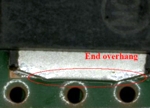The D-PAK iscovered in the IPC-A-610E in section 8.3.14 on page 8-94, "Components withBottom Thermal Plane Terminations". It is also covered in previous revisions ofthe IPC-A-610. The criteriafor end over hand is "No Overhang" for all three classes. For the fullcriteria, the IPC-A-610E is available through the webstore.
Kris Roberson
Manager of Assembly Technology
IPC
Kris Roberson has experience as a machine operator, machine and engineering technician and process engineer for companies including Motorola, and US Robotics. Kris is certified as an Master Instructor in IPC-7711 / 7721, IPC A-610 and IPC J-STD 001.
Reference IPC-A-610 Page8-95, Section 8.3.14 Components with Bottom Thermal Plane Terminations. The End overhang of thermalplane is not allowed; check the second bullet in the Defect Class 1, 2, 3section. Keep in mind that the endface of the of the thermal plane may not be solderable due to the constructionof the device, so the solder joint would be on the bottom of the terminationonly as shown on figure 8-175 on page 8-94. Hopethis is useful.
Leo Lambert
Vice President, Technical Director
EPTAC Corporation
At EPTAC Corporation, Mr. Lambert oversees content of course offerings, IPC Certification programs and provides customers with expert consultation in electronics manufacturing, including RoHS/WEEE and lead free issues. Leo is also the IPC General Chairman for the Assembly/Joining Process Committee.
|



